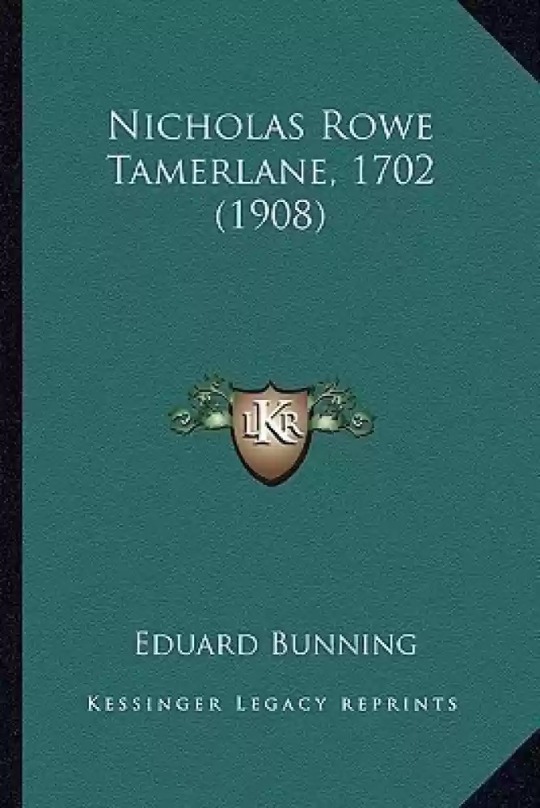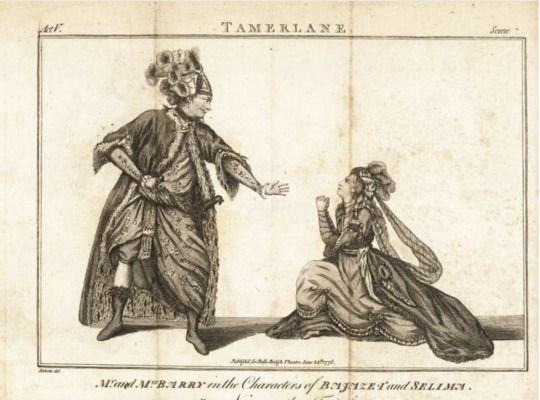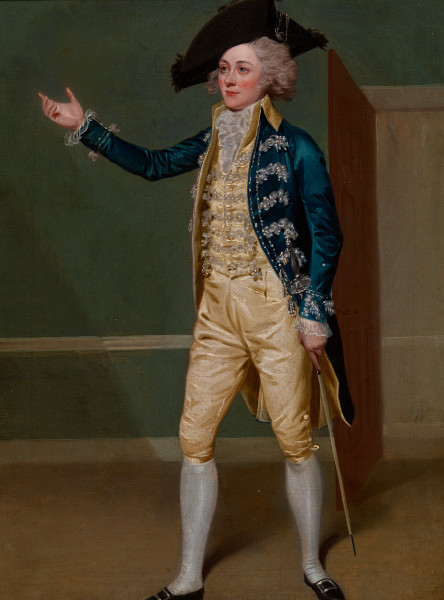#Priscilla Kemble
Text
DESPINA HATUN IN FICTION III
Arpasia
“ Let it come; This Moment then shall shew I am a Greek, And speak my Country's Courage in my suffering.” - The final adieux of Arpasia to Bajazet in the play “ Tamerlane: A Tragedy “ by Nicholas Rowe.
The play named “ Tamerlane: A Tragedy “ was first performed in 1701 at the Lincoln’s Inn Fields Theater in London.

The play which has various historical characters, both fictional and non-fictional, contains two characters inspired by a 14th-century couple from the Ottoman Empire; Despina Hatun and Yildirim Bayezid, Arpasia and Bajazet.
In this artwork, Despina Hatun has heavily influenced the character of Arpasia; the sorrowful bride of Bajazet who has great disdain for her husband, and instead finds solace and comfort in the presence of the fictional Moneses; a prince who shares both her heritage and faith.
The relationship between Arpasia and Bajazet is quite complex in this play. On his part, he is content to have the company of his bride with him during his captivity by Tamerlane though he is quite possessive of her. On her part, she is disgusted by him, not only for his actions towards her but also for their religious differences.
No matter what he does, and what he says he can not win the affection of his wife, though it seems this has been their relationship since the very beginning.
Arpasia accused Bajazet of acting like a tyrant, not only towards her in the past but also towards his people, and yet Bajazet seemed to not care for her words. Though we do not get exact examples of those Tyrant actions he took upon her, some believe it could be related to marital abuse.

Jealous and tired of waiting for his bride to fall upon him, Bajazet gives her an ultimatum; to give herself willingly or he will use another method to have her.
In the end, she ends her life knowing that will be the only way to save herself from him and have the final laugh, in death. Though Bajazet tries to save her, showing that he does have some affection for her, other than his possessiveness ideas over her person, his attempt fails and that is the last we have of them in the play.
The aftermath of her death is probably one of the first times we have an essence of remorse from Bajazet, though it does not last long.
------------------------------------------------------------------------------
Overall, I would say the play and the story of Arpasia (Despina Hatun) do have aspects of early-media feminism, such as her being against her husband's views of seeing her as something to possess at his own time, and her death being some activism against his ideas.
But the play fails, to go more in-depth into what previously happened between them, leaving some confusion in the viewer.
Throughout the whole play, I could sense some biases of the author’s hatred of Bajazet, and his softness towards the character; Tamerlane (Timur) who in real life was not much quite different from the tyrant Bajazet, and yet he appears as one in this deviation.
Yes, I do call it a deviation as the whole time I was focused on finishing this artwork, I could get a sense of deja-vue. As if it was mere fanfiction of the play by Marlowe, but with some changes, as if the author was avoiding the chance to get sued.
#history#english literature#timur#bayezid I#Selima#Ottoman history#ottoman empire#Tamerlane#Nicholas Rowe#Priscilla Kemble#Ms Hopkins#Mrs Hopkins#Restoration period#play#18th century#fiction#Monesses#Moneses#Bajazet#Bayezid#olivera despina hatun#olivera despina#despinahatun#despina hatun#Arpasia#Play#Elizabeth Barry#Theater#bayezid the thunderbolt#hatun
5 notes
·
View notes
Photo

Charlotte Stanton, later Charlotte Goodall, (1766-1830) was a popular 18th century actress noted particularly for comedic and breeches roles. In this circa. 1792 painting by Samuel de Wilde, she is painted in the role of Sir Harry Wildair from ‘The Constant Couple.’ Sir Harry Wildair was a foppish and rakish character, traditionally played by a young woman.
Charlotte Stanton married Thomas Goodall, a merchant captain, in 1787. The marriage was not a happy one and Charlotte eventually ran away with her husband’s lawyer (taking her six children with her). Goodall took his lawyer to court for ‘criminal conversation’ (essentially, a husband wanting compensation from his wife’s lawyer for having sexual intercourse with her). The famous Sir William Garrow represented Goodall in court and produced effusive love letters sent between Goodall’s lawyer and Charlotte as proof of their affair. A complete transcript and description of the trial was published in the name of Charlotte’s husband.
In her lifetime, Charlotte also had a notable quarrel with fellow actress, Priscilla Kemble (of the noted Kemble acting family), over who should play Lady Anne Neville in one of Drury Lane theatre’s many productions of Shakespeare’s Richard III.
83 notes
·
View notes
Text

Ms. Hopkins; also known as Priscilla Kemble in the character of Selima; Bajazet’s fictional daughter.
This line engraving, released in the 18th century was utilized as a commercial advertisement for the play; Tamerlane: A Tragedy, by Nicholas Rowe.
#history#english literature#timur#bayezid I#Selima#Ottoman history#ottoman empire#Tamerlane#Nicholas Rowe#Priscilla Kemble#Ms Hopkins#Mrs Hopkins#Restoration period#play#18th century#fiction
3 notes
·
View notes